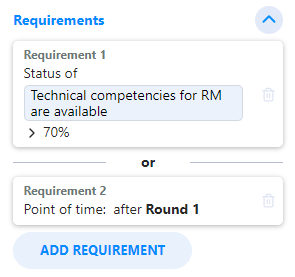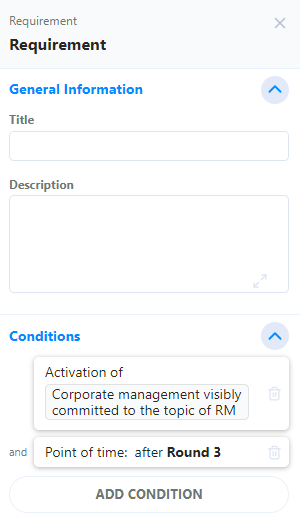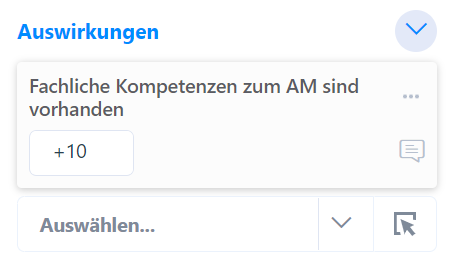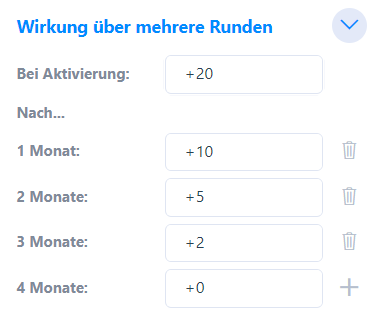Actions
# Create
Actions are used to consciously intervene in the system. In contrast to events that are triggered automatically, actions must be planned manually for each simulation.
Actions are “external influences” on the model. Each action can directly change the state of elements. They are used to react appropriately to events, to take countermeasures or to utilize reinforcement effects.
As a rule, actions cost resources.
Actions can be created by clicking on “Add” and described in detail under the General tab.
# Resource Consumption
The “costs” of the action can be defined here. All entered values are deducted from the respective resources as soon as the action is used during a simulation.
If the resource values are too low when the action is to be activated, the activation fails and the action is not executed.

# Requirements
You can use requirements to define the circumstances under which an action may be carried out. Each requirement has a number of conditions that can be set in the requirements menu.
You can assign any number of requirements to an action. All requirements are independent of the others and their conditions are checked individually. As soon as one requirement is fulfilled, the action can be used.
The requirements can be opened and edited individually.

The conditions for each requirement can be set up in the requirements menu.
Each requirement can have any number of conditions. Only if all the conditions of a requirement are fulfilled is this requirement considered fulfilled and the action can be triggered.
A new condition can be created using the “Add condition” button. This new condition opens in the conditions menu, in which you can set the exact circumstances under which the requirement should be considered fulfilled. All created conditions can be deleted or changed at any time.
Requirements without conditions do not affect the action.
Requirements that contain several conditions are only considered fulfilled if ALL conditions of the requirement are fulfilled at the same time. (AND link)
You can assign a maximum frequency to the action. This limit ensures that the action cannot be used more often than specified here.

# Effects
Actions can change the status of elements or resources in a simulation. This is done with the help of “Effects”.
The elements and resources that the action affects can be selected under the “Effects” tab. To select an object, you can either click on “Select” to choose it from a list or on the arrow symbol next to it to mark it in the network.
You can remove elements from the effects or add new ones at any time.
The selected elements/resources appear in the list of effects. You can use the text field next to each effect to determine the strength of the influence.
Example: We have created an effect for the element “Technical skills for AM are available”. A value of “+10” is entered in the text field. When the action is used, the status of this element is increased by ten points.

Effect over multiple rounds
By default, the effect is applied in the round in which the event occurs. However, you can also spread the effect over several rounds. To do this, click on the title of the effect; a menu will then open with the “Effect over multiple rounds” tab.
In this tab, you can enter in which rounds which effect should occur.

Advanced effect formulas
The text field for entering the effect value supports a range of different possible entries.
Simple forms
| +10 | Add ten points |
|---|---|
| -10 | Subtract ten points |
| =10 | Set the status of the affected element to 10 |
Variables
You can use some predefined variables to make the effect dependent on the current state of the model in the simulation. Simply enter $ in the text field to display a selection of possible variables.
| $Status | Current status of the affected element (value between 0 and 100) |
|---|---|
| $Maximum Status | Maximum status of the affected element. 100 by default. |
| $Minimum Status | Minimum status of the affected element. 0 by default. |
| $Current Round | Number of the current round (1 in round 1, 2 in round 2, etc…) |
Example

The affected element is affected differently depending on the round in which the event occurs. In round 1: +1; but in round 10: +10.
References
You can include the status of other elements or resources in their effect. Simply tap @ to reference another object in the simulation and select the desired object in the selection.
Example

The status of the affected element is reduced by the value of the “Water drainage” element in the entry round.
Calculations
Values can also be offset against each other. The input field supports simple mathematical symbols. (+, -, *, /, “(” and “)”)
Example

The affected element is influenced in inverse proportion to its current state: It receives +20 if it currently has a state of 0, but +0 if its state is 100.
Functions
Functions can be used to generate values that cannot be achieved with simple calculations. Tap # to call up the selection of available functions.
Available functions
| random between (A and B) | Results in a random (integer) number in the specified range, between number A and B (A and B included). |
|---|---|
| modulo (A mod B) | Remainder of a division. Example: modulo(4 mod 3) = 1; |
| smaller value (A or B) | Selects the smaller of two values. Example: smaller value (3 or 7) = 3 |
| greater value (A or B) | Selects the larger of two values. Example: larger value (3 or 7) = 7 |
| rounded (A) | Rounds the number A. Example: rounded(4.3) = 4 |
| rounded down (A) | Rounds the number A down. Example: rounded down(4.7) = 4 |
| rounded up (A) | Rounds the number A up. Example: rounded up(4.1) = 5 |
| absolute (A) | Removes the sign of the number A, is always positive. Example: absolute value(-4) = 4 |
| sign (A) | Results in -1 for a negative number, +1 for a positive number and 0 for 0. Ex: sign(-56) = -1 |
| square root(A) | Returns the square root of A. Example: root(16) = 4 |
| exponent(A ^ B) | Returns A to the power of B. Example: exponent(4 ^ 2) = 16 |
Example
![]()
A random number between 2 and 15 is added to the affected element. (2 and 15 are inclusive)
# Dependent events
Enables actions and events to be linked. A dependent event can be selected from the list of events using the “+new” button. For each dependent event, you can specify after how many rounds and with what probability it should occur.
When a dependent event is created, a new trigger is created for this event.
# Stakeholders
Here you can define the stakeholders of the action. As soon as you have selected a stakeholder from the list of stakeholders by clicking on “Select”, you can describe it in more detail under “General”.
# Design
Allows you to add a suitable image to the action.
